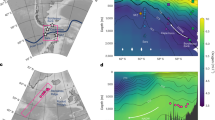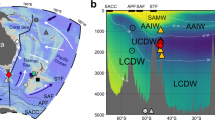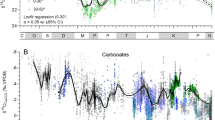Abstract
Temporal variations in the atmospheric concentration of radiocarbon sometimes result in radiocarbon-based age-estimates of biogenic material that do not agree with true calendar age. This problem is particularly severe beyond the limit of the high-resolution radiocarbon calibration based on tree-ring data, which stretches back only to1,2 about 11.8 kyr before present (BP), near the termination of the Younger Dryas cold period. If a wide range of palaeoclimate records are to be exploited for better understanding the rates and patterns of environmental change during the last deglaciation, extending the well-calibrated radiocarbon timescale back further in time is crucial. Several studies attempting such an extension, using uranium/thorium-dated corals3,4,5 and laminae counts in varved sediments6,7,8,9, show conflicting results. Here we use radiocarbon data from varved sediments in the Cariaco basin, in the southern Caribbean Sea, to construct an accurate and continuous radiocarbon calibration for the period 9 to 14.5 kyr BP, nearly 3,000 years beyond the tree-ring-based calibration. A simple model compared to the calculated atmospheric radiocarbon concentration and palaeoclimate data from the same sediment core suggests that North Atlantic Deep Water formation shut down during the Younger Dryas period, but was gradually replaced by an alternative mode of convection, possibly via the formation of North Atlantic Intermediate Water.
This is a preview of subscription content, access via your institution
Access options
Subscribe to this journal
Receive 51 print issues and online access
$199.00 per year
only $3.90 per issue
Buy this article
- Purchase on Springer Link
- Instant access to full article PDF
Prices may be subject to local taxes which are calculated during checkout





Similar content being viewed by others
References
Kromer, B. & Becker, B. German oak and pine 14C calibration, 7200–9400 BC. Radiocarbon 35, 125–136 (1993).
Björck, S. et al. Synchronized terrestrial-atmosphere deglacial records around the North Atlantic. Science 274, 1155– 1160 ((1996)).
Bard, E., Arnold, M., Fairbanks, R. G. & Hamelin, B. 230Th-234U and 14C ages obtained by mass spectrometry on corals. Radiocarbon 35, 191–199 (1993).
Edwards, R. L. et al. Alarge drop in atmospheric 14C/12C and reduced melting in the Younger Dryas, documented with 230Th ages of corals. Science 260, 962–967 ( 1993).
Bard, E. et al. Deglacial sea-level record from Tahiti corals and the timing of global meltwater discharge. Nature 382, 241–244 (1996).
Hajdas, I. et al. AMS radiocarbon dating and varve chronology of Lake Soppensee: 6000 to 1200 14C years BP. Clim. Dyn. 9, 107–116 (1993).
Goslar, T. et al. High concentration of atmospheric 14C during the Younger Dryas cold episode. Nature 377, 414– 417 (1995).
Hajdas, I. et al. AMS radiocarbon dating of annually laminated sediments from Lake Holzmaar, Germany. Quat. Sci. Rev. 14, 137 –143 (1995).
Wohlfarth, B. The chronology of the last termination: a review of radiocarbon-dated, high-resolution terrestrial stratigraphies. Quat. Sci. Rev. 15, 267–284 (1996).
Hughen, K. A., Overpeck, J. T., Peterson, L. C. & Anderson, R. F. in Palaeoclimatology and Palaeoceanography from Laminated Sediments (ed. Kemp, A. E. S.) 171–183 (Spec. Publ. 116, Geol. Soc., London, (1996)).
Peterson, L. C., Overpeck, J. T., Kipp, N. G. & Imbrie, J. Ahigh-resolution late Quaternary upwelling record from the anoxic Cariaco Basin, Venezuela. Paleoceanography 6, 99 –119 (1991).
Hughen, K. A., Overpeck, J. T., Peterson, L. C. & Trumbore, S. Rapid climate changes in the tropical Atlantic region during the last deglaciation. Nature 380, 51–54 (1996).
Overpeck, J. T., Peterson, L. C., Kipp, N., Imbrie, J. & Rind, R. Climate change in the circum-North Atlantic region during the last deglaciation. Nature 338, 553–557 ( 1989).
Rind, D., Peteet, D., Broecker, W. S., McIntyre, A. & Ruddiman, W. The impact of cold North Atlantic sea surface temperatures on climate: implications for the Younger Dryas cooling (11-10 k). Clim. Dyn. 1, 33 (1986).
Johnsen, S. J. et al. Irregular glacial interstadials recorded in a new Greenland ice core. Nature 359, 311– 313 ((1992)).
Paillard, D. Macintosh program makes time-series analysis easy. Eos 77, 379 (1996).
Alley, r. B. et al. Abrupt increase in Greenland snow accumulation at the end of the Younger Dryas event. Nature 362, 527–529 (1993).
Kapsner, W. R., Alley, R. B., Schuman, C. A., Anandakrishnan, S. & Grootes, P. M. Dominant influence of atmospheric circulation on snow accumulation in Greenland over the past 18,000 years. Nature 373, 52–54 (1995).
Druffel, E. M. Decade time scale variabiity of ventilation in the North Atlantic: high-precision measurements of bomb radiocarbon in banded corals. J. Geophys. Res. 94, 3271–3285 ( 1989).
Broecker, W. S., Peteet, D. M. & Rind, D. Does the ocean-atmosphere system have more than one stable mode of operation? Nature 315, 21–26 (1985).
Boyle, E. A. & Keigwin, L. D. North Atlantic thermohaline circulation during the past 20,000 years linked to high-latitude surface temperature. Nature 330, 35–40 (1987).
Stocker, T. F. & Wright, D. G. Rapid changes in ocean circulation and atmospheric radiocarbon. Paleoceanography 11, 773–795 ( 1996).
Mikolajewicz, U. Ameltwater induced collapse of the thermohaline circulation and its influence on the oceanic distribution of δ14C and δ18O. 1– 25 (Tech. Rep. 189, Max-Planck-Inst. für Meteorologie, Hamburg, (1996)).
Keir, R. S. On the late Pleistocene ocean geochemistry and circulation. Paleoceanography 3, 413–445 ( 1988).
Manabe, S. & Stouffer, R. J. Simulation of abrupt climate change induced by freshwater input to the North Atlantic Ocean. Nature 378, 165–167 ( 1995).
Rahmstorf, S. Rapid climate transitions in a coupled ocean-atmosphere model. Nature 372, 82–85 ( 1994).
Charles, C. D. & Fairbanks, R. G. Evidence from Southern Ocean sediments for the effect of North Atlantic deep-water flux on climate. Nature 355, 416– 419 (1992).
Lehman, S. J. & Keigwin, L. D. Sudden changes in North Atlantic circulation during the last deglaciation. Nature 356 , 757–762 (1992).
Stuiver, M. & Pollach, H. A. On the reporting of 14C ages. Radiocarbon 19, 355–359 (1977).
Tric, E. et al. Paleointensity of the geomagnetic field during the last 80,000 years. J. Geophys. Res. 97, 9337– 9351 (1992).
Acknowledgements
We thank S. Trumbore and M. Kerwin for comments that improved the manuscript; B. Kromer and S. Björck for sharing new data for German pine and oak tree-ring chronologies; T. Goslar and E. Bard for sharing numerical data from Δ14C modelling results; H.-L. Lin for 14C dates from core PL07-39PC; and J. Moore for help making thin sections. This work was supported by the US NSF and the National Oceanic and Atmospheric Administration, as well as the US Department of Energy through Lawrence Livermore National Laboratory, and by NSF funding to the Lamont-Doherty Earth Observatory Deep-Sea Sample Repository.
Author information
Authors and Affiliations
Corresponding author
Supplementary information
Rights and permissions
About this article
Cite this article
Hughen, K., Overpeck, J., Lehman, S. et al. Deglacial changes in ocean circulation from an extended radiocarbon calibration . Nature 391, 65–68 (1998). https://doi.org/10.1038/34150
Received:
Accepted:
Published:
Issue Date:
DOI: https://doi.org/10.1038/34150
This article is cited by
-
Seasonality in the North Sea during the Allerød and Late Medieval Climate Optimum using bivalve sclerochronology
International Journal of Earth Sciences (2009)
-
Tree rings and ice cores reveal 14C calibration uncertainties during the Younger Dryas
Nature Geoscience (2008)
-
Melt-Water-Pulse (MWP) events and abrupt climate change of the last deglaciation
Science Bulletin (2008)
-
Timing of the late glacial and Younger Dryas cold reversal in southern Chile varved sediments
Journal of Paleolimnology (2008)
-
Comments on “Corrected western Atlantic sea-level curve for the last 11,000 years based on calibrated 14C dates from Acropora palmata framework and intertidal mangrove peat” by Toscano and Macintyre [Coral Reefs (2003) 22:257–270]
Coral Reefs (2005)
Comments
By submitting a comment you agree to abide by our Terms and Community Guidelines. If you find something abusive or that does not comply with our terms or guidelines please flag it as inappropriate.



